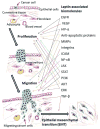The potential role of leptin in tumor invasion and metastasis
- PMID: 29158066
- PMCID: PMC5720178
- DOI: 10.1016/j.cytogfr.2017.11.002
The potential role of leptin in tumor invasion and metastasis
Abstract
The adipocyte-released hormone-like cytokine/adipokine leptin behaves differently in obesity compared to its functions in the normal healthy state. In obese individuals, elevated leptin levels act as a pro-inflammatory adipokine and are associated with certain types of cancers. Further, a growing body of evidence suggests that higher circulating leptin concentrations and/or elevated expression of leptin receptors (Ob-R) in tumors may be poor prognostic factors. Although the underlying pathological mechanisms of leptin's association with poor prognosis are not clear, leptin can impact the tumor microenvironment in several ways. For example, leptin is associated with a number of biological components that could lead to tumor cell invasion and distant metastasis. This includes interactions with carcinoma-associated fibroblasts, tumor promoting effects of infiltrating macrophages, activation of matrix metalloproteinases, transforming growth factor-β signaling, etc. Recent studies also have shown that leptin plays a role in the epithelial-mesenchymal transition, an important phenomenon for cancer cell migration and/or metastasis. Furthermore, leptin's potentiating effects on insulin-like growth factor-I, epidermal growth factor receptor and HER2/neu have been reported. Regarding unfavorable prognosis, leptin has been shown to influence both adenocarcinomas and squamous cell carcinomas. Features of poor prognosis such as tumor invasion, lymph node involvement and distant metastasis have been recorded in several cancer types with higher levels of leptin and/or Ob-R. This review will describe the current scenario in a precise manner. In general, obesity indicates poor prognosis in cancer patients.
Keywords: Invasive cancer; Leptin; Metastasis; Obesity; Prognosis.
Copyright © 2017 Elsevier Ltd. All rights reserved.
Conflict of interest statement
The authors have no conflict of interest to declare.
Figures




References
Publication types
MeSH terms
Substances
Grants and funding
LinkOut - more resources
Full Text Sources
Other Literature Sources
Research Materials
Miscellaneous

